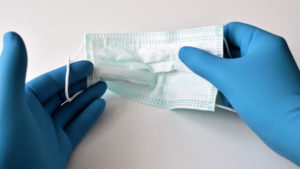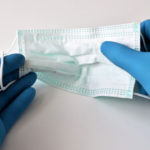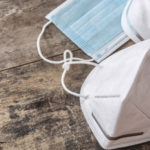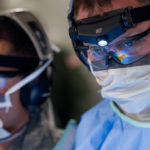ASTM F2299M Test Method
Standard Test Method for Determining the Initial Efficiency of Materials Used in Medical Face Masks to Penetration of Particulates Using Latex Spheres
F2299M (F2299/F2299M – 03 (Re-approved 2017) is a laboratory-based test method which measures the particle filtration efficiency of various materials used for medical face masks.
This filtration efficacy test compares particle counts before a test media meets a filter apparatus (upstream) and then measures again after (downstream) the test media passes through the material.
Measuring Airborne Particles & Filtration
The test results are generated by shooting aerosolized particles through a sample mask material.
Monodispersion is a technique which scatters particles of a controlled size into an airflow stream. For this test, the monodispersed particle size distributions has a mean diameter of 0.1 to 5 um with a mean diameter of (+plus/-minus) 10%.
Filtration Efficacy Test Method:
- Filtered, dry air passes through an atomizer which produces an aerosol containing suspended latex spheres
- The aerosol is then passed through charge neutralizer
- The aerosol is then mixed and diluted with additional preconditioned air. The result is a stable, neutrally charged, and dried aerosol of latex spheres.
- Airborne particle counts are then measured with a particle counter
Particles tend to clump together in the air. Charge neutralization prevents the particles from dispersing unevenly or behaving erratically due to electrostatic charge and electrostatic cling.
Continue: What is a Particle Counter? How Do They Work?
Environmental Conditions for ASTM Testing
Monitoring airborne particles requires a controlled environment. Particle counters do not measure particle composition, only its size and quantity in a specific diameter. Any extraneous particles from the test operators, immediate environment, air source, or test devices can affect accuracy. Likewise, the size of emitted particles is also effected by humidity.
Continue: Air Sampling Tests of Airborne Droplets vs Real-World Conditions
Airborne Particulate Size
The test only evaluates artificially generated particles between 0.1 and 5.0 um.
Airborne particulates exist in range between large visible particles and extremely small (ultrafine particles). By design, liquid particles over 5.0 um are considered droplets, while particles below 5.0 um are considered aerosols. Particulates or droplets over a size of 10 um are filterable by the upper respiratory system. Particles smaller than 0.1 are increasingly hard to measure while also capable of penetrating far deeper into the lungs.

How Have Face Masks Changed Over Time? A Brief History of Face Coverings
Masks were not always made from advanced textiles and multilayer construction. What makes these materials so meaningful when manufacturing PPE equipment, and how has mask technology changed over time?

Where Can I Buy FDA Approved KN95 Masks?
When you buy face masks from PAC you’ll have the benefit of masks shipped from USA warehouses, in-stock availability, and bulk pricing.

What’s a Medical Mask? Why is It Different from a Procedural Mask?
Medical masks by definition, must be validated at a minimum of ASTM Level 1.

What are the Standards for ASTM Face Mask Testing?
This post will help you understand the context, performance criteria, and minimum requirements of ASTM levels in various medical masks and their respective uses fields.

Surgical Medical Masks ASTM Level 3 Requirements
This post will help you understand meaningful differences between various face mask evaluation methods and best-case use. Understanding the most common mask materials and expected performance metrics helps buyers better decide which mask is most appropriate for associated risk, cost, and wellbeing.

ASTM F2299M Medical Face Mask Test Method – Filtration Efficacy Testing
The F2299M filtration efficacy test compares particle counts before a test media meets a filter apparatus (upstream) and then measures again after (downstream) the test media passes through the material.
Continue: Airborne Droplets – Nuclei Aerosols Explained – Mechanisms and Characteristics
Related Posts
-
What are the Standards for ASTM Face Mask Testing?
This post will help you understand the context, performance criteria, and minimum requirements of ASTM levels in various medical masks and their respective uses fields. ASTM General Overview ASTM is the american society for testing…
-
Face Mask Definitions & Terms
Define surgical mask, filtering respirator, 3 ply mask, and medical mask.
-
Face Masks in 2022: It's Time to Update Your Knowledge About Face Masks
It’s been a year since the COVID-19 pandemic started and it looks like face masks are not going away anytime soon. With the pandemic continuing, this is the year to update your knowledge about face…
-
Surgical Medical Masks ASTM Level 3 Requirements
This post will help you understand meaningful differences between various face mask evaluation methods and best-case use. Understanding the most common mask materials and expected performance metrics helps buyers better decide which mask is most…
-
What's a Medical Mask? Why is It Different from a Procedural Mask?
Medical masks by definition, must be validated at a minimum of ASTM Level 1.
-
How Have Face Masks Changed Over Time? A Brief History of Face Coverings
Masks were not always made from advanced textiles and multilayer construction. What makes these materials so meaningful when manufacturing PPE equipment, and how has mask technology changed over time?










